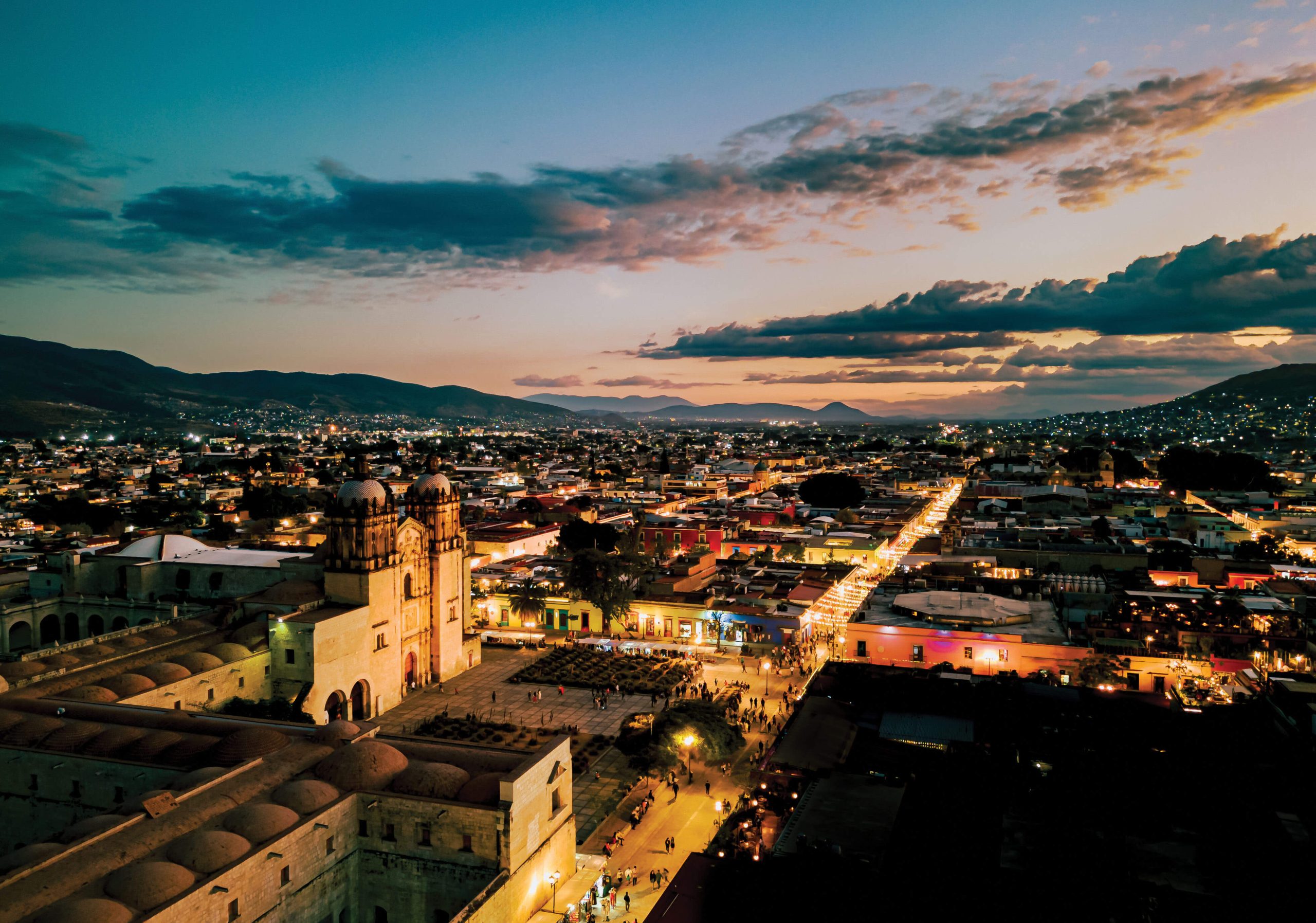
04 Jan Wanderings: A City of Celebrations
It’s the first week of October in Oaxaca de Juárez. Día de los Muertos is three weeks off, but the city is already in its grip. Fireworks punctuate the night. A mural has just been completed in Xochimilco, and it must be acknowledged with a boom. A parade around the neighborhood will follow, and more fireworks. In a week, fresh-cut marigolds will turn the city a bright shade of orange.
While Día de los Muertos is celebrated throughout Mexico, it’s famously vibrant in Oaxaca, the capital of the eponymous state in Mexico. It lasts seven days, with community-wide parades and all-night graveside vigils in cemeteries, where families wait for the souls of their beloveds.
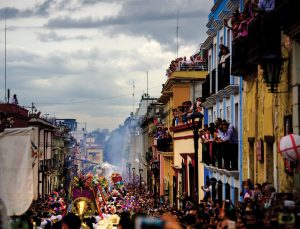
Calendas, or celebratory processions, are a part of life in Oaxaca.
Streets close to traffic and tents are raised for artisans to sell their work: handcrafted items like woven rugs and wall hangings, carved alebrijes — or brightly painted animals — decorative tin ornaments and mirrors, crafts at the heart of the 16 Indigenous cultures that have inhabited this region since before time.
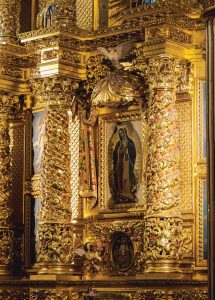
The altar in Templo de Santo Domingo is painted in gold leaf with niches featuring images of saints, including the Virgin of Guadalupe.
The festival isn’t even the city’s largest or most exuberant of the year. That prize goes to Guelaguetza, the Zapotec word for “reciprocal sharing of gifts.” At this, communities from the state’s eight regions gather in Oaxaca to share their distinct traditional dances, food, and music. It lasts the month of July. In spring, coinciding with the start of Lent, the city celebrates Carnaval. There is also a mezcal festival; a festival for the Patron Saint of Oaxaca, Soledad, and one for the Virgin of Guadalupe; and for the radish; and the mushroom. If they are not cleaning up after one celebration, they are gearing up for the next. Longtime Oaxaca residents claim to be accustomed to the late-night sounds of marching bands and fireworks.
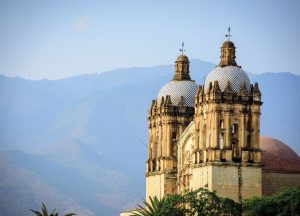
The bell towers of Templo de Santo Domingo are a classic example of Baroque architecture and a symbol of the region’s historic evangelizing by Spain. Photos: Douglas Favero
In 2023, Travel & Leisure readers voted Oaxaca the best city in the world to visit, beating out the sophistication of London and the romance of Paris. Readers based their votes on things such as landmarks, sights, culture, food, and value. Even an inexperienced traveler would have to put Oaxaca at the top in each category. So ancient and saturated with culture is the city that it was declared a World Heritage Site by UNESCO in 1987, ensuring its preservation.
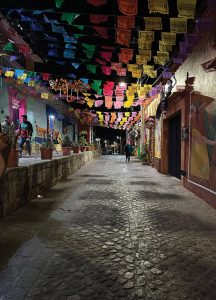
Barrio Xochimilco is the oldest neighborhood in the city and is widely known as a community of artisans. Photo: Isabelle Walker
“Oaxaca is addictive,” says Tanivet Flores, a native Oaxacan who teaches Spanish in a language school downtown. “We have culture, we have architecture, we have history, food, and customs. And we are a happy city; we will welcome you.”
Stroll down to the Zócalo, or the center square, past 400-year-old churches and capacious two-story mansions with courtyards and balconies wrapped in their original ironwork, and you could find yourself in the middle of a wedding parade, as bride and groom are escorted by a marching band, dancers, and guests from Templo de Santo Domingo de Guzmán to their reception downtown. Widely known as the most beautiful Catholic church in Mexico, it draws couples from all over Mexico to be married there.
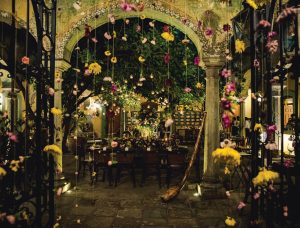
During festivals, buildings and courtyards are festooned with flowers and skeletons. Here, guests at Hotel Casa Sierra Azul enter a courtyard through a curtain of Mexican sunflowers. Photo: Douglas Favero
High in the hammock of two mountain ranges — Sierra Madre del Norte and Sierra Madre del Sur — the Oaxaca Valley is balmy year-round and botanically diverse. More than 40 species of agave grow in the wild there, making it the mezcal capital of the world. Taste for the ancient spirit is surging globally, and family-run distilleries in tiny pueblos are getting attention from foreign investors and travelers who like their liquor with a high proof and smoky flavor. There’s a tasting room on almost every block downtown, and you can tour the mezcal factories outside the city.
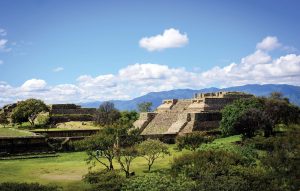
The ruins of Monte Albán sit on a hill 6 miles west of Oaxaca. Established around 500 BC, it was the center of Zapotec political, spiritual, and economic life and an architectural wonder. Photo: Douglas Favero
This beautifully walkable city offers so much to the curious and adventure-loving traveler. If you make it to the Zócalo, you’ll be a few blocks from Mercado 20 Novembre. This vast and noisy market, named for when the Mexican Revolution began, is frequented mostly by locals and lets you dip pleasantly into Oaxacan gastronomy. Platters heaped high with chapulines — or roasted grasshoppers, which many find tasty with lime and garlic — will greet you at the entrance. Moving right along, you’ll be in a sea of food booths. Places like Comedor María Teresa, Comedor Betty, and Comedor Chabelita. Must-tries include tamale Oaxaqueño, which are tamales wrapped in banana leaves; tlayudas with Oaxacan quesillo (it resembles mozzarella); chocolate de agua — cinnamoned, almondy, and warm. “We don’t eat our chocolate; we drink our chocolate,” says Flores.
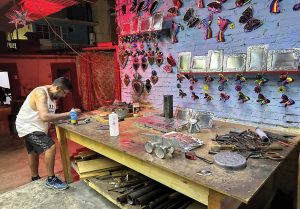
This Xochimilco tin workshop was founded 78 years ago by Miguel Angel Arguello. Here, one of Arguello’s sons works after hours to finish a piece.
Pasillo de Humo, or Hall of Smoke, is where the meat is. Every kind, raw and on display. You choose what you want, along with seasonal vegetables, and they will grill it while you wait. There’s a lot of smoke.
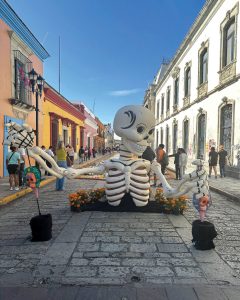
In late October, Macedonia de Alcála becomes a palate for Dia de los Muertos decorations. Photos: Isabelle Walker
Afterward, walk up Calle García Virgil and a gentle incline will bring you to the ancient barrio of Xochimilco, settled in pre-Hispanic times by Zapotec farmers. Today, it’s a community of weavers and tinsmiths. You can poke your head in and see what they’re doing. The ruins of an 8th-century aqueduct add to the beauty. Murals are all over — chromatic and narrative, often featuring hummingbirds or colibrís. They’re considered messengers of love.
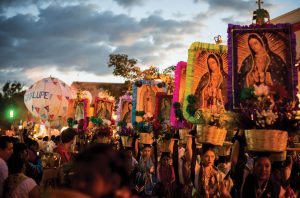
Every year on December 12, Oaxacans celebrate the Virgin of Guadalupe with a calenda. In the morning, parents dress their children in traditional peasant garb and visit the Iglesia de Guadalupe for a blessing.
If you visit Oaxaca during Día de los Muertos, midnight tours of cemeteries on October 31st are available. Take one if you can. You’ll see how families gather around the graves, each one aglow with candlelight and under a blanket of fresh marigolds. Some families sit quietly around them on lawn chairs; some hire a mariachi band to serenade their departed; others tell stories and pass the mezcal. Will their dead loved ones return? They’ll be there if they do.
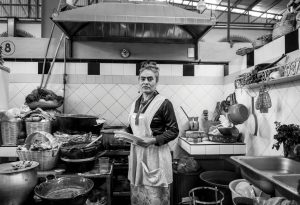
After Beatriz Vázquez Gómez’s father told her she looked like Freida Kahlo, she looked at a photo of the famous Mexican painter and agreed. Later, deciding to “go with it,” she opened a restaurant named after the painter and began to dress like her. La Cocina de Frida is located just south of Oaxaca in Ocotlán.
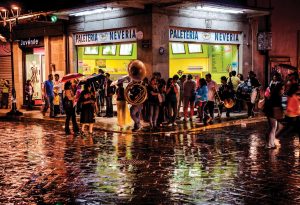
Caught in the rain, members of a calenda gather outside an ice cream store in Oaxaca’s historic El Centro. Photo: Douglas Favero
Isabelle Walker lives in Santa Barbara, California, where she teaches and writes creative nonfiction and poetry. She has a Master of Fine Arts from Antioch University, Los Angeles.
DINING
Casa Oaxaca el Restaurante
+52.951.516.8889; casaoaxacaelrestaurante.com
Criollo
+52.951.320.0709; criollo.mx
Hierba Dulce (Vegan)
+52.951.516.5374; hierba-dulce.com
Levadura de Ollo
+52.951.269.9068; levaduradeollo.mx
Los Danzantes
+52.951.501.1184; losdanzantesoaxaca.com.mx
Restaurante Catedral
+52.951.516.3285; restaurantecatedral.com.mx
Tierra del Sol
+52.951.516.8641; tierradelsol.mx
LODGING
Casa Antonieta
+52.951.688.8517; casaantonieta.com
Casa de las Bugambilias
+52.951.516.1165; casadelasbugambilias.com
Casa Naila Hotel Boutique
+52.951.688.8467; casanaila.com
Hotel Castillo Santa Cecilia
+52.473.732.0485; castillosantacecilia.com.mx
Quinta Real Oaxaca
+52.951.501.6100; caminoreal.com/en/quintareal/quinta-real-oaxaca/
Museums & Attractions
Centro Fotográfico Álvarez Bravo
+52.951.516.9800; cfmab.com.mx
Hierve el Agua (petrified waterfalls)
+52.951.502.1200
San Lorenzo Albarrradas, Oaxaca
In Situ Mezcalería
+52.951.514.1811; insitumezcaleria.com
Jardín Etnobotánico de Oaxaca
+52.951.516.5325; jardinoaxaca.mx
Mezcaloteca
+52.951.514.0082; mezcaloteca.com
Monte Albán Archaeological Site
whc.unesco.org/en/list/415
Museo de Arte Contemporáneo de Oaxaca
+52.951.514.2228; macooaxaca.com
Museo de las Culturas de Oaxaca
+52.951.516.2991; sic.gob.mx
Museo de los Pintores Oaxaqueños
+52.951.516.5645; sic.cultura.gob.mx
Museo Textil de Oaxaca
+52.951.501.1617; museotextildeoaxaca.com






No Comments